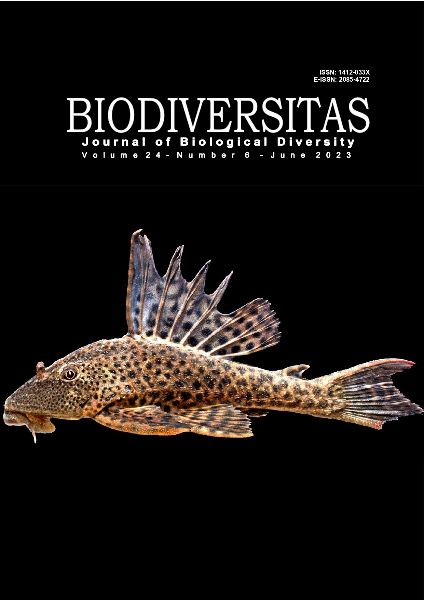Screening and evaluation of antidiabetic activities of endophytic fungi associated with Etlingera elatior
##plugins.themes.bootstrap3.article.main##
Abstract
Abstract. Nurjannah L, Azhari A, Wulandari AP, Amin S, Supratman U. 2023. Screening and evaluation of antidiabetic activities of endophytic fungi associated with Etlingera elatior. Biodiversitas 24: 3481-3487. Etlingera elatior (Jack) R.M.Sm. has been well-documented to have antioxidant and antidiabetic properties. Among all medical conditions worldwide, diabetes mellitus is one of the leading causes of death. Therefore, research on the discovery of antidiabetic medicines inhibitory to ?-glucosidase (an enzyme for degrading complex dietary carbohydrates into sugar in the digestive process) is urgently needed. This study aims to isolate and evaluate the potential of the fermentation culture of endophytic fungi associated with E. elatior to inhibit the activity of ?-glucosidase. The endophytic fungi were isolated from various parts of E. elatior. A total of 29 isolates were successfully isolated from the plant's roots, stems, leaves, and flowers. The endophytic fungi were tested for their ability to inhibit ?-glucosidase activity in bioassays. Among those isolates, 8 were inhibitory to such an enzyme, and 2 showed the highest inhibitory activities. Morphotype and molecular identification of those isolates, using their Internal Transcribed Spacer (ITS) regions of ribosomal DNA (rDNA), identified them as Daldinia eschscholtzii isolate CFL 7 and Hypoxylon trugodes voucher YMJ 57, with IC50 values of 738 µg/mL and 825 µg/mL, respectively. That indicates that they are potentially used in preventing or treating diabetic mellitus.
##plugins.themes.bootstrap3.article.details##
Most read articles by the same author(s)
- YENI MULYANI, ASRI PENI WULANDARI, SISKA ELISAHBET SINAGA, WAHYU SAFRIANSYAH, AZMI AZHARI, SARI PURBAYA, FAJAR FAUZI ABDULLAH, KINDI FARABI, YOSHIHITO SHIONO, UNANG SUPRATMAN, Antibacterial activities and molecular identification of endophytic fungi isolated from mangrove Avicennia marina , Biodiversitas Journal of Biological Diversity: Vol. 24 No. 12 (2023)

